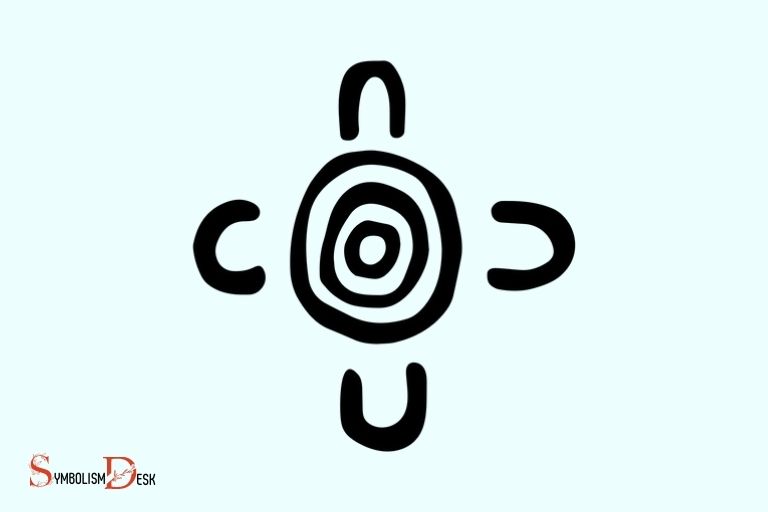What Do Aboriginal Symbols Mean? Communication!
Aboriginal symbols are visual forms of communication used by indigenous Australian communities.
They depict a wide range of concepts, stories, cultural values, and customs, each with its unique meaning.
For example, a U shape often represents a person, wavy lines symbolize water or a path, while circles can signify a campsite or waterhole.
Aboriginal symbols often feature in art and are used to share knowledge and preserve culture.
These symbols can change in meaning depending on the context or the region they originate from. Their interpretation can be complex, especially as many symbols have spiritual or religious significance.
In essence, Aboriginal symbols are a rich form of communication that serves to preserve indigenous Australian culture.
They enable stories to be passed down through generations and facilitate a deeper understanding of Aboriginal connections to the land, community, and spirituality.
These symbols have a dynamic role, as their meanings can shift based on the context or region, emphasizing the diversity and complexity of Aboriginal cultures.
12 Symbols Meanings of Aboriginal
| Symbol | Meaning |
|---|---|
| Circle | Community, campsite, spiritual place, or waterhole (depending on context) |
| U Shape | Person, usually seated |
| Concentric Circles | Meeting place, waterhole, or resting place |
| Wavy Lines | Water or Rain |
| Straight Lines | Travel routes or journey pathways |
| Spiral | Whirlwind or Hurricane |
| Rectangle | Coolamon (carrying vessel) |
| Oval | Woman, or womb (depending on context) |
| Footprints | Evidence of human or animal activity |
| Zigzag Lines | Kangaroo tracks or Running Water (depending on context) |
| Dots | Stars, Spiritual Energy, or Sand (depending on context) |
| Animal Drawings | Represents the specific animal and their traits and behaviours |
Key Takeaway

Five Facts About: The Meanings of Aboriginal Symbols
Understanding Aboriginal Symbols: An Overview
Aboriginal symbols are an essential and crucial component of australia’s cultural heritage, as they represent the values, beliefs, and traditions of its indigenous people.
These symbols have been used for countless generations and possess great significance both spiritually and culturally. These symbols have been used for countless generations and possess great significance both spiritually and culturally. Among them, certain hand gestures carry profound interpretations, such as the hamsa, often associated with protection and blessings. The hand symbol meaning in Judaism, for instance, often ties to the concept of divine protection and the guarding presence of God, reflecting its deep-rooted spiritual symbolism. These timeless symbols continue to resonate, bridging tradition and modernity.
The following are the key points that will provide an overview of aboriginal symbols, their importance, and their historical significance.
What Are Aboriginal Symbols And Why Are They Important?
Aboriginal symbols are graphic representations that convey various meanings and messages unique to the indigenous people of australia.
These symbols played a significant role in aboriginal storytelling, depicting dreamtime stories, history, and traditions.
Their importance is based on the unparalleled connection they share with the land and how these symbols are inextricably linked to indigenous cultural identity.
Some of the key points to consider when understanding aboriginal symbols:
- Aboriginal symbols depict various aspects of aboriginal life, including landscapes, animals, and human figures.
- These symbols highlight the rich cultural history of aboriginal people and provide insight into the evolution of their society.
- Symbols were also used as a means of communication between different indigenous language groups and served as a common language.
Historical Background And Significance Of Aboriginal Symbols
Aboriginal symbols have a rich history and spiritual significance that dates back over tens of thousands of years.
The meaning of each symbol varies among different aboriginal groups, and many of these symbols have complex, multi-layered meanings.
The key points to consider when delving deeper into the historical background and symbolic significance of aboriginal symbols:
- Aboriginal symbols played a significant role in dreamtime stories and the creation of the world.
- These symbols were passed down from one generation to another through storytelling, song, and dance.
- The birthing of symbols was often accompanied by spiritual ceremonies and initiation rites that were undertaken by young indigenous men and women.
Understanding aboriginal symbols is essential in appreciating their cultural heritage and the indigenous people of australia.
These symbols have a significant place in australian history, and it’s critical to respect their cultural significance.
The Meaning Behind Aboriginal Symbols
Aboriginal symbols are an integral part of indigenous australian culture. These symbols represent their stories, heritage, and their histories. Aboriginal symbols are a blend of their land, food, and environment.
The symbols might look simple at first, but each one tells a unique and fascinating story.
Here are some of the important points about the meaning behind aboriginal symbols:
The Purpose Of Aboriginal Symbols
Aboriginal symbols serve many purposes in indigenous culture. These symbols are deeply connected with the rituals, beliefs, and practices of the aboriginal people.
Some of the main purposes of aboriginal symbols are:
- To pass on the knowledge of the culture, traditions, and customs of the aboriginal people from generation to generation.
- To express social laws, stories, and traditional practices in a visual way.
- To connect the spiritual world with the physical world and convey the essence of the aboriginal people’s relationship with their land.
Interpretation And Significance Of Various Symbols Used In Aboriginal Art
Aboriginal symbols have many different meanings, and the interpretation of each symbol can vary depending on the context.
Some of the significant symbols used in aboriginal art and their meanings include:
- The circle: Represents the cycle of life and the universe.
- The spiral: Represents growth, life, and progress.
- The dots: Represent people, rocks, and water.
- The u-shape: Represents a person or a woman.
Moreover:
- The wavy lines: Represent movement, water, or a snake.
- The straight lines: Represent paths, boundaries, or travel.
- The handprint: Represents the presence and role of the artist in the creation of the artwork.
The Role Of Storytelling In Aboriginal Symbols
Storytelling is crucial to the aboriginal culture. Aboriginal symbols play a vital role in storytelling, meaning, and communication.
Storytelling with symbols usually involves an artist who translates an idea or story into a visual representation.
The role of storytelling in aboriginal symbols is:
- To preserve and pass down stories, beliefs, and traditions from generation to generation.
- To create a powerful connection between people, land, and the spirit world.
- To inform, educate, and enrich the aboriginal community.
The meaning behind aboriginal symbols is multifaceted and complex. The symbols have significant cultural importance, and each one is unique and full of fascinating stories.
Understanding these symbols is essential to appreciate aboriginal art and indigenous culture.
Cultural Significance Of Aboriginal Symbols
Aboriginal symbols are an integral part of the culture of indigenous australians.
The symbols carry deep and complex meanings, reflecting the cultural values and beliefs of indigenous australians.
How Aboriginal Symbols Reflect Cultural Values And Beliefs
Aboriginal symbols are both an artistic form and a means of communication. They communicate stories, ideas, and concepts that are central to indigenous australian culture. These symbols often draw on elements of the natural world, such as animals, plants, and landscapes, and are used in ceremonial and everyday contexts. They provide a way for indigenous Australian peoples to connect with their heritage and express their identity. In a similar way, the use of symbols is also important in Scottish culture, as evidenced by the rich tradition of the Scottish symbols chart, which carries meaning and significance for the Scottish people. Just as Aboriginal symbols convey stories and ideas, Scottish symbols also hold a deep cultural and historical value for those who use and interpret them.
Some key points about how aboriginal symbols reflect cultural values and beliefs are:
- Aboriginal symbols are often highly abstract and stylized. This reflects indigenous australians’ belief that the power of a symbol lies not in its visual representation but in its spiritual significance.
- Many aboriginal symbols are associated with the dreamtime, the period when indigenous australians believe the world was created. Symbols associated with the dreamtime often have deep spiritual significance, reflecting indigenous australians’ understanding of their place in the world.
- Aboriginal symbols are often used to communicate practical information, such as maps of waterholes, campsites, and hunting grounds.
The Importance Of Maintaining The Integrity Of Aboriginal Symbols
The appropriation of aboriginal symbols by non-indigenous australians and international markets is a concern for indigenous australians.
Some key points about the importance of maintaining the integrity of aboriginal symbols are:
- Aboriginal symbols are a sacred part of indigenous australian culture and should only be used with permission and in an appropriate manner.
- Non-indigenous australians and international markets have a responsibility to respect the cultural significance of aboriginal symbols and to ensure that their use does not trivialize or misrepresent indigenous australian culture.
- Maintaining the integrity of aboriginal symbols is essential for ensuring the ongoing cultural and spiritual vitality of indigenous australian communities.
Examples Of How Aboriginal Symbols Have Been Appropriated And How It Impacts The Community
The appropriation of aboriginal symbols is an ongoing issue that has significant impacts on indigenous australian communities.
Some key examples of how aboriginal symbols have been appropriated and how it impacts the community are:
- The use of aboriginal symbols in fashion and design without permission or payment to indigenous australian artists. This has led to indigenous australian artists and communities missing out on financial benefits and having their cultural heritage commodified.
- The use of inappropriate or inaccurate aboriginal symbols in marketing and advertising campaigns. This misrepresents indigenous australian culture and reinforces negative stereotypes.
- The appropriation of aboriginal symbols for commercial gain without recognition of their cultural significance. This perpetuates a colonial narrative that trivializes indigenous australian culture.
Aboriginal symbols hold significant cultural and spiritual significance for indigenous australians. The appropriation of these symbols harms indigenous australian communities and reinforces colonial narratives.
It is crucial to maintain the integrity of aboriginal symbols, to respect their cultural significance, and to seek permission before using them.
Understanding The Process Of Creating Aboriginal Symbols
The aboriginal culture is so rich and diverse, with a vast history dating back thousands of years. One of the defining features of aboriginal culture is the use of symbols in their artwork.
Aboriginal symbols act as a visual language that tells stories of their ancient customs, traditions, and practices.
Understanding the process of creating aboriginal symbols helps to appreciate the art form’s complexity and meaning.
Traditional Techniques And Materials Used To Create Aboriginal Symbols
Aboriginal symbols have been created using traditional techniques and materials for centuries.
These include:
- Dot painting: Using natural pigments and colored dots, a series of symbols are created in a sequence that tells a story.
- Carvings: Creating wooden or stone sculptures, which are then engraved or carved with symbols.
- Sand art: Using colored sand to create intricate designs unique to the aboriginal culture.
- Basket weaving: A traditional technique where symbols are woven into intricate basket designs or mats.
The Relationship Between The Artist And Their Creation
For aboriginal artists, the symbols they create go beyond just a visual representation of their culture. Each symbol carries a meaning and significance that relates to a particular story, tradition, or event.
The artist’s relationship with their creation is rooted in a spiritual connection with their ancestors and the land.
The artist’s connection ensures that the symbols are accurate in portraying the story or tradition they represent.
Examples Of Contemporary Aboriginal Artists And Their Work
Contemporary aboriginal artists continue to showcase this ancient art form through their work.
Some examples of contemporary aboriginal artists include:
- Emily kngwarreye: Known for her abstract compositions of dots and lines representing her country and its dreaming stories.
- John mawurndjul: An acclaimed bark painter who incorporates powerfully symbolic images of his ancestral country in his art.
- Gloria petyarre: Regarded as one of the leading figures in contemporary aboriginal art, petyarre’s paintings often depict the stories of her country and its sacred sites.
The process of creating aboriginal symbols is a crucial aspect of their culture.
From the use of traditional techniques and materials to the spiritual connection between the artist and their creation, it is clear that aboriginal symbols hold a significant meaning.
The examples of contemporary aboriginal artists showcased their work and how they continue to evolve this ancient art form.
Can Understanding Aboriginal Symbols Help in Understanding Dropbox Symbols?
Understanding Aboriginal symbols is a fascinating way to delve into ancient cultures. These symbols, however, are vastly different from understanding dropbox sync symbols. While Aboriginal symbols hold spiritual and cultural significance, Dropbox symbols are practical indicators of file statuses. Both symbols serve distinct purposes and learning about them can enhance our appreciation for diverse forms of communication.
What Does the Levi Symbol Mean in Relation to Communication?
The Levi symbol holds profound meaning and symbolism in relation to communication. Representing the balance between silence and expression, it signifies effective and authentic communication. This symbol encourages individuals to convey their thoughts, emotions, and ideas with clarity, while also emphasizing the importance of active listening and understanding. Through the levi symbol meaning and symbolism, communication becomes a powerful tool for connection and mutual growth.
FAQ About What Do Aboriginal Symbols Mean?
What Are Some Common Aboriginal Symbols?
Aboriginal symbols include animals, humans, weapons, spiritual beings, and landscapes, with each having different meanings according to their culture.
What Do Turtle Symbolize In Aboriginal Culture?
Turtles are symbols of mother earth and represent longevity, endurance, and persistence.
What Is The Meaning Of Aboriginal Dot Painting?
Dot painting is an ancient technique used by aboriginal people to tell stories of land, ancestry, and culture.
How Were Aboriginal Symbols Created?
Aboriginal symbols were traditionally created by carving or painting onto rocks, caves, and other natural surfaces.How Were Aboriginal Symbols Created?
How Do I Incorporate Aboriginal Symbols Into My Art?
You can incorporate aboriginal symbols into your art by researching their meanings, learning about the traditional techniques, and respecting the cultural significance.
Conclusion
Aboriginal symbols are not just a symbol; they are the way of life and a language. These symbols have been passed down from generations and are still used by aboriginals all over the world.
Every symbol has a meaning, which reflects their culture and traditions.
Although some of these symbols may be obscure and difficult to comprehend, they are meant to be appreciated and interpreted accordingly.
The symbols have a plethora of meanings from nature to animals, and they all showcase the rhythm and history of the aboriginal community.
These symbols also serve as a medium for storytelling and cultural significance. They inspire artists, designers, and writers to incorporate aboriginal culture into their works and appreciate the diversity of indigenous culture.
Aboriginal symbols are a powerful and compelling rendition of art, creativity, and storytelling, and we should all respect and acknowledge their powerful cultural significance.






